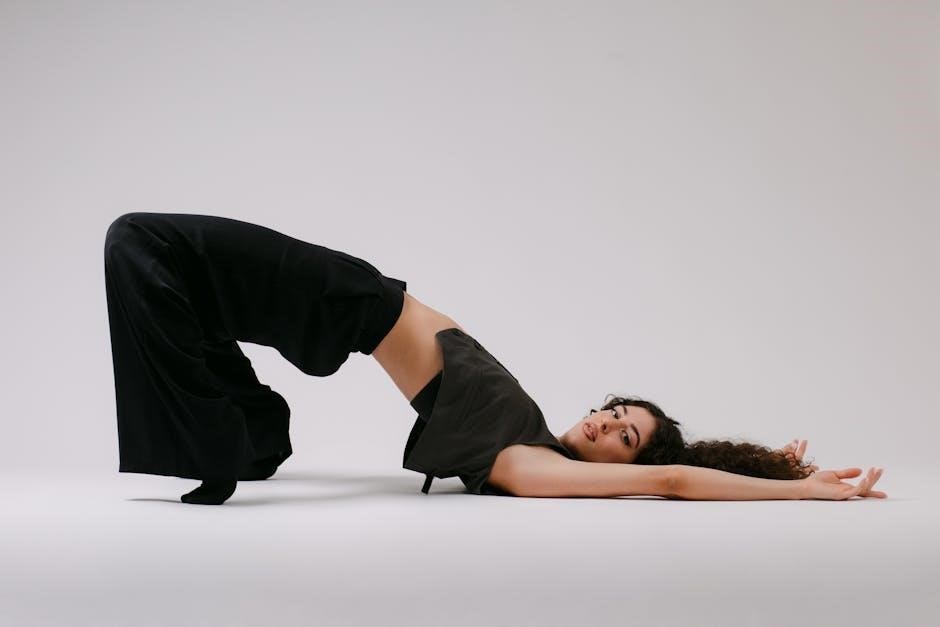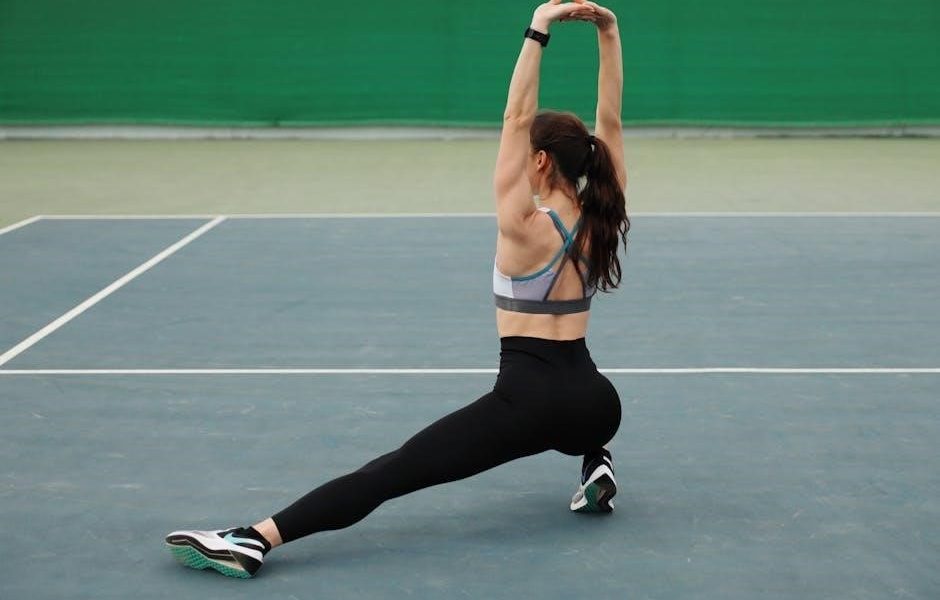Hamstring stretches are essential for improving flexibility, reducing muscle tightness, and preventing injuries. Regular stretching enhances mobility, supports daily activities, and boosts athletic performance. Learn how to perform them effectively for optimal benefits.
Understanding the Importance of Hamstring Flexibility
Hamstring flexibility is crucial for maintaining proper posture, reducing muscle tension, and enhancing movement efficiency. Tight hamstrings can limit pelvic mobility, increase lower back stress, and disrupt daily activities. Regular stretching helps lengthen these muscles, improving range of motion and reducing injury risk. Flexible hamstrings also support athletic performance by enabling powerful hip and knee movements. Over time, consistent stretching can alleviate tightness, promote better posture, and prevent strains, making it a cornerstone of both rehabilitation and preventive care for overall lower body health.
How Hamstring Stretches Can Improve Mobility and Reduce Injury Risk
Hamstring stretches enhance mobility by increasing flexibility and reducing muscle tension, allowing for smoother, more efficient movement. Regular stretching improves range of motion, making daily activities and athletic performances easier. It also reduces the risk of injuries by preventing muscle strains and pulls, which often occur due to tightness or imbalances. Flexible hamstrings promote proper posture and alignment, lowering the strain on surrounding muscles and joints. This makes stretching a vital practice for both active individuals and those seeking to maintain or improve their overall physical functionality and health.

Anatomy of the Hamstrings
The hamstrings consist of three muscles: the biceps femoris, semitendinosus, and semimembranosus. Located at the back of the thigh, they play a key role in knee flexion and hip extension.
The Role of Hamstrings in Movement and Posture
The hamstrings play a crucial role in movement by enabling knee flexion and hip extension, essential for activities like walking, running, and maintaining balance. They also contribute to proper posture by stabilizing the pelvis and lower back. Tight hamstrings can limit pelvic mobility, increasing stress on the lower back and disrupting posture. Regular stretching helps maintain flexibility, reducing the risk of poor posture and related discomfort. Understanding their function is key to appreciating the importance of incorporating targeted stretches into a fitness or rehabilitation routine.
Muscle Groups Targeted by Hamstring Stretches
Hamstring stretches primarily target the three muscles of the posterior thigh: the biceps femoris, semitendinosus, and semimembranosus. These exercises also engage the calf muscles and glutes, promoting overall lower body flexibility. Tight hamstrings can restrict movement and cause discomfort, so stretching helps improve muscle elasticity and reduce tension. By targeting these specific muscle groups, individuals can enhance mobility, alleviate tightness, and support proper muscle function. Regular stretching ensures balanced muscle development and prevents imbalances that could lead to injury or poor posture.

Benefits of Hamstring Stretches

Hamstring stretches improve flexibility, reduce muscle tension, and enhance mobility. They help prevent injuries, alleviate lower back pain, and boost athletic performance and everyday activities. Consistent practice yields long-term benefits for overall muscle health and posture.
Reducing Tightness and Improving Range of Motion
Regular hamstring stretching effectively reduces muscle tightness, enhancing flexibility and range of motion. Tight hamstrings often limit movement and posture, but consistent stretching can gradually lengthen the muscles. This improvement allows for better mobility in daily activities and sports, reducing stiffness and discomfort. By incorporating exercises like seated stretches or standing reaches, individuals can experience noticeable relaxation in the hamstrings. Over time, this leads to improved joint mobility and reduced strain on the lower back, promoting overall musculoskeletal health and preventing potential injuries.
Preventing Hamstring Injuries and Strains
Hamstring injuries are common, but regular stretching can significantly reduce the risk. Tight muscles are more prone to strains, so maintaining flexibility through exercises like seated stretches or standing reaches helps prevent tears. Strengthening the hamstrings alongside stretching enhances resilience. Incorporating dynamic stretches before activities and static stretches post-workout ensures muscles are prepared for exertion and properly cooled down. This routine minimizes the likelihood of strains, supports recovery, and keeps the hamstrings strong and adaptable for both athletic pursuits and everyday movements, promoting long-term injury prevention and overall lower limb health.
Enhancing Athletic Performance and Everyday Activity
Hamstring stretches play a crucial role in enhancing both athletic performance and daily functionality. Flexible hamstrings improve range of motion, enabling better power and efficiency in activities like running, cycling, and jumping. Strong, flexible hamstrings also reduce muscle imbalances, which can enhance overall posture and movement quality. For athletes, this translates to faster sprint times and longer jumps, while for everyday life, it means easier walking, climbing stairs, and maintaining proper spinal alignment. Regular stretching fosters muscle resilience, ensuring hamstrings can handle the demands of both sports and routine tasks without fatigue or strain.

Types of Hamstring Stretches
Hamstring stretches vary, including standing, seated, and supine options. Standing stretches are convenient, while seated stretches offer deep flexibility. Supine stretches provide gentle mobilization, targeting different muscle groups for personalized benefits.
Standing Hamstring Stretches for Convenience
Standing hamstring stretches are ideal for quick and easy flexibility work. One effective stretch involves placing the heel of one leg on a step, keeping the knee straight, and gently leaning forward to feel the stretch in the back thigh; Another variation is standing with feet shoulder-width apart, bending forward at the hips, and reaching toward the toes, holding for 20-30 seconds. These stretches are perfect for incorporating into a daily routine, requiring minimal space and equipment. They improve circulation, reduce muscle tension, and enhance overall mobility, making them a practical choice for busy schedules and pre- or post-workout sessions. Regular practice promotes better posture and reduces the risk of lower back strain by maintaining flexible hamstrings. Consistency is key to achieving lasting benefits, so aim to perform these stretches 2-3 times weekly, gradually increasing flexibility and strength. Over time, standing stretches can significantly contribute to injury prevention and improved athletic performance. Always ensure proper form to maximize effectiveness and avoid discomfort. If tightness persists, consider combining with seated or supine stretches for a comprehensive approach to hamstring health. Remember, gentle stretching is more effective than forcing beyond a comfortable range; Patience and consistency yield the best results for long-term flexibility and muscle balance. Incorporate these stretches into your routine today for enhanced mobility and overall well-being.
Seated Hamstring Stretches for Deep Flexibility
Seated hamstring stretches offer a deep and effective way to improve flexibility. The butterfly stretch involves sitting with soles together, knees dropped, and leaning forward to stretch the hamstrings. Another option is the seated forward bend, where knees are slightly bent, and hands reach toward the feet. For added depth, a towel can assist in extending the reach. These stretches target the entire hamstring group, promoting relaxation and lengthening tight muscles. Regular practice enhances posture, reduces lower back tension, and improves mobility. Hold each stretch for 20-30 seconds, breathing deeply, and repeat 2-3 times for maximum benefit. Consistency is key to achieving lasting flexibility and preventing injury.
Supine Hamstring Stretches for Gentle Mobilization
Supine hamstring stretches provide a gentle and effective method for mobilizing tight muscles. Lie on your back and lift one leg, keeping the knee slightly bent. Gently pull the leg toward your chest until a stretch is felt in the back of the thigh. Use a towel or strap to deepen the stretch if needed. This stretch is ideal for those with limited mobility or recovering from injuries. It promotes relaxation, improves circulation, and enhances flexibility without strain. Perform 2-3 sets, holding each stretch for 20-30 seconds, to gradually lengthen the hamstrings and reduce tension. This method is perfect for rehabilitation and maintenance of muscle health.

Dynamic vs. Static Hamstring Stretches
Dynamic stretches involve movement, improving circulation and flexibility, while static stretches are held longer, enhancing muscle length and relaxation. Both aid in injury prevention and performance.
Dynamic Stretches for Pre-Activity Warm-Ups
Dynamic stretches are movements that prepare the hamstrings for activity by increasing blood flow and reducing stiffness. Examples include leg swings, high knees, and lunges. These stretches improve flexibility and range of motion, making them ideal for warm-ups. They mimic sports-specific movements, enhancing performance and reducing injury risk. Incorporating dynamic stretches before exercise or athletics ensures muscles are ready for action, promoting better mobility and power. Regular practice strengthens the hamstrings and improves overall athletic efficiency, making them a crucial part of any pre-activity routine.
Static Stretches for Post-Activity Recovery
Static stretches involve holding a position to lengthen the hamstrings, ideal after activity to promote recovery. Techniques like seated stretches or standing hamstring pulls target tight muscles, reducing soreness. Holding stretches for 20-30 seconds allows for maximum relaxation and flexibility gains. Incorporating static stretches post-exercise helps repair muscle fibers, enhancing recovery and reducing stiffness. Regular practice improves range of motion and prevents future injuries, making them essential for long-term muscle health and overall physical performance.

How to Perform Hamstring Stretches Effectively
Proper technique is key for effective hamstring stretches. Hold stretches for 20-30 seconds, breathe deeply, and avoid bouncing to maximize flexibility and prevent injury.
Proper Technique for Maximum Benefit
Hamstring stretches require precise form to ensure effectiveness and safety. Start with a warm-up to prepare muscles. When stretching, maintain a straight leg and gently lean forward until a mild stretch is felt. Avoid bouncing, as it can cause micro-tears. Hold each stretch for 20-30 seconds to allow the muscle to relax and lengthen. Keep your back straight and engage your core to maintain stability. Focus on controlled movements and avoid pushing past discomfort to prevent injury. Consistency and patience are key for achieving lasting flexibility.
Duration and Frequency of Stretching Sessions
For optimal results, hold each hamstring stretch for 20-30 seconds and perform 2-3 sets per session. Aim to stretch 3-5 times weekly, allowing muscles to recover between sessions. Consistency is key for gradual improvement in flexibility. As flexibility increases, you can progressively extend the duration of stretches. However, avoid overstretching, as it may lead to discomfort or injury. Regular practice, even for a few minutes daily, yields better long-term results than infrequent, prolonged sessions. Adjust your routine based on individual progress and comfort levels to maintain a balanced approach to hamstring flexibility.

Hamstring Stretches for Specific Needs
Targeted stretches address injuries, lower back pain, and rehabilitation. Tailored exercises enhance recovery, reduce discomfort, and improve mobility for specific conditions, ensuring effective and safe progress.
Stretches for Hamstring Injury Rehabilitation
Rehabilitation stretches focus on gentle, controlled movements to promote healing and strength. Start with supine stretches, where lying on your back allows for minimal strain while extending the hamstrings. Use a towel or strap to assist in pulling the leg towards you, holding for 20-30 seconds. Progress to seated stretches, bending forward slowly to stretch the back of the thighs, ensuring not to bounce. These exercises, done 2-3 times daily, help restore flexibility and strength, reducing the risk of re-injury and supporting a full recovery.
Hamstring Stretches for Lower Back Pain Relief
Tight hamstrings often contribute to lower back pain by limiting pelvic movement and altering posture. Gentle stretching can reduce muscle tension and alleviate discomfort. Standing stretches, such as leaning forward at the hips with straight knees, target the hamstrings effectively. Seated stretches, like reaching toward the toes, provide deep flexibility. Supine stretches, where the leg is lifted while lying down, offer a gentle approach. Regular practice improves posture, reduces stress on the lower back, and minimizes pain flare-ups. Incorporate these stretches 2-3 times daily for optimal relief and long-term benefits.

Incorporating Hamstring Stretches into Your Routine
Consistency is key. Start with short daily sessions, track progress, and adjust as flexibility improves. Make stretching a habit for long-term benefits and injury prevention.
Creating a Daily Stretching Schedule
Consistency is crucial for effective hamstring stretching. Start with 5-10 minute sessions daily, ideally in the morning or after light activity. Warm up with gentle movements before stretching. Incorporate a mix of standing, seated, and supine stretches to target all areas. Focus on holding each stretch for 20-30 seconds to maximize flexibility. Track your progress weekly, adjusting the intensity and duration as your range of motion improves. Prioritize stretches that address tightness or discomfort, ensuring a balanced routine that supports both mobility and muscle relaxation. Over time, this consistent practice will yield noticeable improvements in flexibility and overall comfort.
Tracking Progress and Adjusting Your Routine
Monitoring your progress in hamstring stretching is key to achieving long-term flexibility. Use a log to record the duration, intensity, and ease of each session. Note improvements in range of motion or reductions in muscle tightness. Adjust your routine based on these observations, gradually increasing the depth or duration of stretches as flexibility enhances. If progress stalls, consider incorporating new stretches or seeking professional guidance. Regular reflection ensures your routine remains effective and tailored to your evolving needs, helping you maintain consistent improvement over time.

Common Mistakes to Avoid
Overstretching and poor form are common errors that can lead to injury. Ensure proper technique and avoid bouncing to maintain muscle integrity and achieve safe, effective stretching.
Overstretching and Its Consequences
Overstretching can cause micro-tears in the hamstrings, leading to pain, inflammation, and prolonged recovery. It often results from improper technique or excessive force. To avoid this, focus on gentle, controlled movements and stop if discomfort arises. Holding stretches for 20-30 seconds is ideal, as bouncing or forcing beyond a natural range can damage tissues. Chronic overstretching may weaken muscles, reducing their stability and increasing injury risk. Prioritize gradual progress and listen to your body to ensure safe and effective stretching practices that enhance flexibility without compromising muscle integrity or overall well-being.
Neglecting Proper Form During Stretches
Neglecting proper form while stretching can lead to ineffective results and potential injury. Incorrect postures or movements may strain unrelated muscles, causing discomfort or pain. For instance, arching the back during hamstring stretches can put pressure on the spine, risking harm. It’s crucial to maintain a straight knee and stable pelvis to target the correct muscle group. Ignoring proper alignment can reduce the stretch’s effectiveness and increase the risk of muscle imbalances. Always prioritize precise technique to ensure safety and maximize the benefits of each stretch for optimal flexibility and muscle health.
Consistent hamstring stretching improves flexibility, reduces injury risk, and supports recovery. Regular practice promotes long-term muscle health and enhances overall athletic and daily performance.
The Long-Term Benefits of Consistent Hamstring Stretching
Consistent hamstring stretching leads to improved flexibility, reduced muscle tightness, and enhanced mobility over time. Regular practice lowers the risk of injuries, supports better posture, and alleviates lower back pain. It also boosts athletic performance by increasing power and endurance. Long-term stretching promotes balanced muscle development, preventing muscle imbalances that can lead to chronic issues. Additionally, it enhances recovery after workouts, reducing muscle soreness and stiffness. By incorporating hamstring stretches into your routine, you can achieve lasting benefits for both physical health and overall well-being. Over time, consistent stretching fosters stronger, more resilient muscles, supporting an active lifestyle.
Resources for Further Learning and PDF Guides
For comprehensive guidance, numerous PDF guides and online resources offer detailed hamstring stretching routines. Websites like Sussex MSK Partnership provide downloadable PDFs with step-by-step exercises. These guides often include illustrations and tips for proper technique. Additionally, fitness experts and physical therapists share stretching protocols tailored for injury prevention and recovery. Many resources emphasize the importance of consistency and gradual progression. You can also find video tutorials and printable charts to track your stretching routine. Leveraging these tools ensures you adopt a well-rounded approach to improving hamstring flexibility and overall muscle health.
